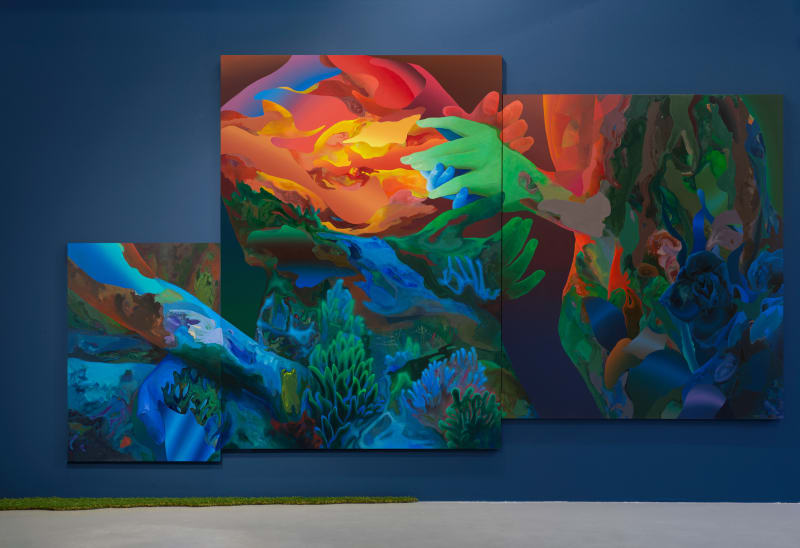For this series, Jüris has collected a selection of Estonian folk game instructions found in the national archives, blending them with her own memories and interpretations.
The devil sits on a rock, while players 1, 2, 3, and 4 place their hands on the Devil’s head. They circle the Devil asking if they could heat up the sauna. The Devil is a joker, replying humorously like “no, the roof of the house is blue on every third Monday” and more in that tone. The moment the Devil says yes, the players attack the rock as the Devil tries to stop them and at the same time carry out a counter-attack. If the Devil is successful in its attack, the touched player becomes the new Devil, and the game restarts.
An introduction to the painting "The Devil’s Game", based on a text from Põrgupapamäng/The Devil’s game; Tartu; Eesti Rahvamänge, A.Kalamees, p. 58.
as the day fades into midnight hues explores human relationality and cohabitation through the act of playing. Game culture and folklore are rich in variation – not only are games ever-changing in time, but different age and social groups and even neighboring villages might have their own versions of the same game. How widely a game has been played in the world is reflective of human diversity – many are characteristic to just a small geographical area, while others are universal. In addition, each game type has its own function, be it entertainment, celebration, ritual, or for strengthening unity and a sense of belonging in a community. Many games that were popular centuries ago had belief-related, ritualistic, and even magical origins. Swinging and tugging games, as just one example, were believed to promote agricultural prosperity and good health. Many adult cultural customs carried over to children’s games. Games today generally have more entertaining purposes.
This series of paintings is both conceptually and technically a play – a play on childhood nostalgia and on the need to find footing in dubious times by exploring one’s past as well as it is a play with the painted matter. For this series, Jüris has collected a selection of Estonian folk game instructions found in the national archives, blending them with her own memories and interpretations. Jüris paints in an intuitive, slow, and layered manner. The will of the acrylic material dictates the artistic process. She treats the painted matter as an agent in its own right, allowing unexpected forms and patterns to emerge as the paint flows and withers across the canvas. As the painterly landscape grows and evolves, bodily shapes and synergies are identified and brought forth through found shapes painted in a highly controlled manner. Jüris takes advantage of the acrylics’ characteristics, such as their vibrancy and dullness as well as their fluency and transparency, to create a sense of beautiful apprehension – a subtle conflict between joy and unease, as well as a conflict between classical painting, arts and crafts and post-internet aesthetics.
Siiri Jüris (b. 1992) is an Estonian painter, currently living and working in Uppsala, Sweden. She holds an MFA from the Royal Institute of Art in Stockholm (2021) and an MFA in painting from the University of Tartu (2017). Jüris has participated in many group exhibitions, mainly in Estonia, but also in Sweden, Slovakia, and Lithuania. She was one of the finalists for the Young Painter Prize in both 2019 and 2021, and in 2020 she won the “Young Tartu” competition. Jüris’ solo exhibition matter that (em)bodies was held at the Tartu Art Museum in February 2021, and her solo exhibition as the day fades into midnight hues opened on November 11, 2022, at Galleri Duerr.

